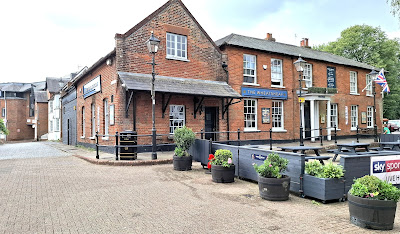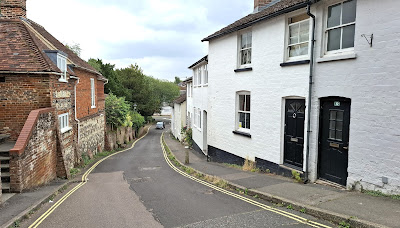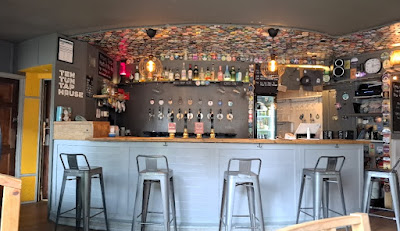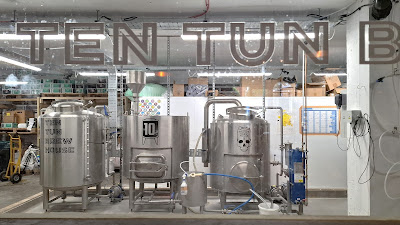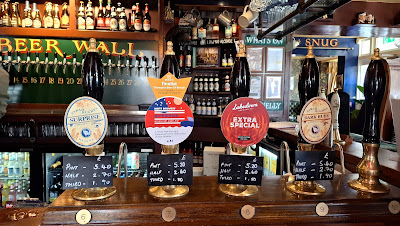The Hop Blossom’s website describes itself as a “pub for all seasons,” that offers a warm welcome year-round. In winter it's a cosy retreat, perfect for enjoying a refreshing pint of beer while roasting chestnuts on the open fire. During summer, the pub is a place to sit at one of the outside tables whilst soaking up the Surrey sunshine in style. Whatever the season, the Hop Blossom had a really nice feel to it and was the sort of pub that I’d be happy to make as my local, is I lived in the town.
Farnham’s own Nelson Arms was the next pub on the itinerary, and this was my second, and as rather more relaxed visit to this attractive looking pub, as explained at the beginning of this piece. Situated a short distance up the aptly named Castle Street, (the town’s castle is situated towards the top of this hillside street), the Nelson is a half-timbered building, dating from the 14th century. It’s had a coat of paint since my previous visit (see photo above), which in my view enhances the pub, but apart from that, little has changed, certainly externally. Before entering the Nelson, I couldn’t help noticing the blackboard sign outside, advertising home made pies. Had I known this, and had the timings been right, I would have gone for the pie option, rather than the Club Ciabatta at the Queen’s Head, although that would have meant a very late lunch! The beer range at the Nelson was as follows: Hogs Back TEA, plus two similar beers from Timothy Taylor – Golden Best, plus Landlord, of course, although you knew that! I went for the TEA, which I think I had last time around, and with everyone’s glass suitably charged, we decamped, en masse to the large double room, the other side of the fireplace. Looking back over the photos, most of the party seemed engrossed in their phones – perhaps some urgent Discourse matter had come up. Speaking of which, I discovered that one Discourse member present, lives a short train ride away from me, in the village of Marden. Once again, I can’t recall his name, although Martin might remember who he was. A few final words on the Nelson, regarding the rather solid and very traditional feel to the part of the pub where we were sitting. There are many original dark beams and some exposed brickwork with a log fire in between the two main seating areas. The furniture is varied and comfortable with some settee. According to the pub’s website, the Nelson can be very busy serving food early evenings, although that wasn’t my experience three years ago. Full marks though to a lovely old pub that manages to infuse its obvious history, with a more modern twist. Moving on to the penultimate pub of the day, saw us walking back towards the town centre and to the mind-boggling, Teller’s Arms. This conversion by Young’s of a former Lloyd's bank, into a modern gastro-pub, is somewhere that has to be seen. Think spacious and high ceiling, lots of upholstered seating, rugs, dark wood, chandeliers and old portraits adorning the walls, and you are transported back in time to an old London pub, that is obviously at the smart end of the spectrum. This was the obvious intention of the pub company, but it does seem to work. There is a strong focus on food, which is served all day, although plenty of non-dinning spaces are provided. Young’s London Original (so original that it’s brewed in Wolverhampton), plus a Hog’s Back beer complete the lineup on the bar, but quite frankly, Young’s beers are a pale shadow of what we enjoyed 20-30 years ago, when they were still brewed in Wandsworth. A stunning pub though, which must have cost the Pubco a fortune to kit out. It’s large enough to get lost in, and there seem plenty of places to hide, for those who don’t want be seen. I haven’t got a huge amount to say regarding the Borough Beer House, which was the final Farnham pub of the day. I haven’t got any photos, either, but to complete the record the pub opened in December 2023, in a building that dates from 1674. It was formerly the Bailiff's Hall in Farnham’s historic Town Hall, the one that seems to have been replaced by a more modern version – see photo, opposite. The downstairs seating area is quite small although there is a larger upstairs room, which is where most of us gravitated to. With six hand-pumps serving a variety of cask ale styles from around the UK, normally including a dark beer, a best bitter and something “new wave”, plus eighteen keg lines, providing a range of changing beers from UK, Belgium and beyond. My beer choice to finish on, was Siren Multiverse Dark Mild, a mid-strength cask ale. I left around the same time as Martin, although with a train back to Alton to catch, he went on ahead. My train wasn’t due to depart until later, and when it did come it was on time. Connections at Guildford and Redhill all went to plan, and I was back in Tonbridge in time for the last bus of the day, which saved a hike up to Bailey Towers. Verdict – another excellent day out, and one in a part of the country that is often overlooked.


























